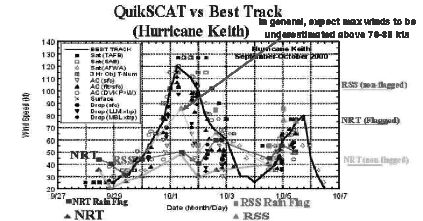Topic 0.2.b: Imminent uses and data assimilation
Title: Applications of scatterometer data in tropical cyclone research, forecasting, and analysis
Presenter: Roger T. Edson
Anteon Corporation
Water and Environmental Research Institute (WERI)
University of Guam
University of Guam Station
Mangilao, Guam 96924, USA
E-mail: rogeredson@yahoo.com or redson@uog.edu
Fax: 671.734.8890
0.2.b.1 Introduction
Global coverage of scatterometer data over tropical cyclones has been routinely available to the tropical cyclone (TC) forecasters and researchers since 1991. However, it has only been since 1999 that the SeaWinds instrument on board the QuikSCAT satellite has offered near-continuous daily coverage of over 90% of the tropical oceans. This enhanced coverage has presented an opportunity for the various TC forecasting centers and other operational weather agencies to adapt these data into near-real time use. The scatterometer provides both surface wind speed and direction which significantly increases the TC forecaster’s knowledge of TC formation and TC surface wind structure. Current research shows that QuikSCAT wind speeds are found to be extremely accurate, especially for the interpretation of the radius of gale-force winds and positioning requirements. However in many cases, the data are difficult to directly analyze without using various interpretation procedures. In extensive rain regions, light winds are often greatly overestimated. In high winds, the current empirical algorithm generally underestimates the speeds above 30 to 40 m/s and is not tuned to the tight gradients and curvatures that are typical in TCs. The greatest interpretation issues are the correct wind direction selection procedure and the effect of rain on the wind retrieval process. However, research is currently underway that will help resolve some of these issues. This report discusses uses of scatterometer data in TC research and forecasting and analysis and makes recommendations for future uses and requirements. A companion paper will describe in more detail the mechanics of scatterometry and the wind retrieval process as well as some suggested methods for using QuikSCAT data in near-real time TC analysis.
0.2.b.2 Operational uses of Scatterometer Data over Tropical Cyclones
a) TC Analysis (Winds)
QuikSCAT data are currently used to gain knowledge of tropical cyclone genesis, position, movement, outer wind structure, and provide a 'minimum’ (at least) estimate of the maximum sustained winds (Liu and Chan 1999; Chu et al. 2000; Magnan et al. 1999; Atlas et al. 2002) . These ingredients have been used to some degree by all the global TC forecasting and research centers since the data became available in the near-real time in the mid 1990s (Quilfen et al. 1998; Edson 1997). In the past, there have been some difficulties when using the QuikSCAT data directly without a great deal of pre-analysis manipulation, including the use and determination of rain-affected wind vector cells (wvc) and the ambiguity selection process. In addition, the various automated ambiguity selection methods have problems when the TC circulation center can not be resolved due to excessive rain-flagged wvc in the inner core, or when the center is not accurately positioned in the comparison Numerical Weather Prediction (NWP) analysis. Therefore, the degree of use, besides from the timeliness and accessibility of the data, is and has been dependent upon how each forecaster, and forecast agency, has formed an understanding and a confidence for the data (Edson et al. 2002). In the case of QuikSCAT, implementation of the data into the NWP assimilation process only began in January 2002 for the NCEP and ECMWF models (other agencies had previously used the ERS scatterometer data). Implementation of formal procedures for the use of the data in the TC warning process still do not exist and the need continues for validation of the data under conditions of high winds and rain. Also, an automated (or user interface) process to properly pick the correct wind solutions near the center of the TC is desired. Examples of current TC
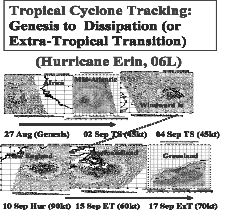 analysis techniques using scatterometer are shown in Figure 0.2.b.1 a,b.
analysis techniques using scatterometer are shown in Figure 0.2.b.1 a,b.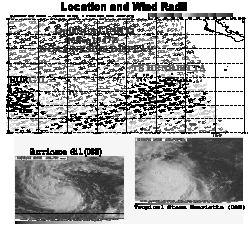
a) b)
Fig 0.2.b.1: Demonstration of determining location and outer 35 kt wind radii (a) and location and tracking of a TC from genesis to extratropical transition (b).
b) TC Analysis (Normalized Radar Cross-Section, NRCS)
Especially promising are new positioning techniques that take advantage of the variable range processor onboard QuikSCAT that produce an effective 6 km- resolution, gray shade, normalized radar cross-section (NRCS) image (Edson and Chang 2003). These high resolution images show promise not only in pinpointing developing TCs, but also in larger scale analyses as well (Fig 0.2.b.2).
Fig 0.2.b.2: Analysis with the QuikSCAT NRCS. The NRCS shows promise in providing analysis of both the large scale and small scale flow (a), positioning and evidence of eyewall structure (b), and positioning and analysis with QuikSCAT winds and ambiguities for hard-to-find systems (c).
c) Early TC Detection and Genesis
Other research show promise in the ability to identify the incipient disturbance earlier than previously achieved with satellite imagery (Katsaros et al. 2001; Sharp et al. 20002). Although Sharp et al.’s method has been developed as an automated process with mixed results; this author believes that an analyst can manually, with the help of other remote sensing data, more easily determine whether a center exists(Fig.0.2.b.3).
Fig. 0.2.b.3: Early analysis of pre-TD07L. QuikSCAT winds and NRSC image can reinforce an analysis of a suspect area when other imagery and data are inconclusive.
0.2.b.3 Validation of QuikSCAT Data over TCs
a) QuikSCAT Data
Winds are adjusted to simulate a neutral atmosphere at 10 m as compared to 8-10 minute buoy data. Validation studies by Freilich and Dunbar (1993); Wentz and Smith (1999); Jones (2002); and Smith et al. (2000), show that the scatterometer data have met or exceeded the science program requirements (Perry 2000). An example of one such study is shown in Figure 0.2.b.4.
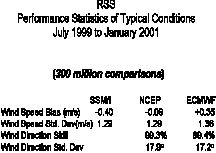
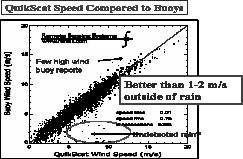
Fig. 0.2.b.4: QuikSCAT verification data from RSS (Smith et al. (2000)).
b) Wind Speed Limitations
There continues to be a debate about the exact range that space-based Ku-band radar can measure wind speeds. Fig 0.2.b.4 and subsequent research, Atlas et al.(2002) and others, clearly show that QuikSCAT winds have met or exceeded the scientific standard for the wind speed range between 3-30 m/s:
+- 2 m/s or 10% (greater of) wind speed uncertainty for 3-30m/s
+- 20 degrees wind direction uncertainty for 3-30 m/s.
Verification of winds in a higher range than this standard have had mixed results because of the difficulty of retrieving a statistically significant sample of buoy or ship data in these regions. In addition, it is difficult to assess how rain extinction typical within the inner core of a TC affects the results. Meteorologically, it is also difficult to determine exactly how extensively any comparison region exceeds 30-50 m/s in the high gradients of the TC with respect to the QuikSCAT 25 km footprint. Some studies are currently looking at redefining the QuikSCAT ‘box’ to more aptly fit the tight gradients and curvatures in the TC (Jones 2002; Long 2000). Studies from aircraft measurements (P. Black, personal communication) using a Ku-band (v-pol) instrument show saturations above 40 m/s. However, Smith et al. (2000) show cases where QuikSCAT winds compared favorably with wind speeds in excess of 50 m/s in extratropical systems. Wentz (personal communication) believes the difference between the Smith et al. results and earlier studies are due to the h-pol sensor onboard QuikSCAT that shows a positive response to winds up to and exceeding 60-70 m/s (but with increasing variance). He also states that the QuikSCAT’s use of a higher frequency and higher incident angle to that of the earlier ERS studies help to obtain these higher measurements. In any case, more verification is required under TC conditions.
c) Validation of TC structure and intensity with QuikSCAT data
Research by Edson (1997, 2000, and 2002) compares QuikSCAT winds with TC intensity and wind structure. Qualitative agreement such as in the examples in Fig 0.2.b.5 show how well the QuikSCAT wind structure of Hurricane Dennis agrees with the aircraft data; while QuikSCAT maximum wind intensities, although low below 30 m/s, match well with the best track intensities for Hurricane Keith below this value (of course, horizontal gradients may also be the determining factor for resolving the highest winds over a 25 km area).
